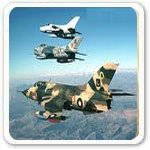Comparison of Indian and Pakistani Forces
 Two Germanys, two Koreas and two countries, Pakistan and India have been at brinkmanship since their inception and are always showing saber-ratting. Pakistan and India have been at logger heads over the Kashmir issue since their partition in 14 August, 1947. Both of the countries have similar land, culture and climate but a highly different religious basis. After the independence and partition into two countries, Pakistan chose to be an Islamic republic and aligned with USA in cold war. India on other hand did not show any alliance with any of the two superpowers but get financial and political support from the both poles in various time spam. India, but, has some more tight ties with former USSR. These choices turned out to the turning point in the political and military future of both these countries and it decided the present state of Indian and Pakistani military strengths which we will evaluate below.
Two Germanys, two Koreas and two countries, Pakistan and India have been at brinkmanship since their inception and are always showing saber-ratting. Pakistan and India have been at logger heads over the Kashmir issue since their partition in 14 August, 1947. Both of the countries have similar land, culture and climate but a highly different religious basis. After the independence and partition into two countries, Pakistan chose to be an Islamic republic and aligned with USA in cold war. India on other hand did not show any alliance with any of the two superpowers but get financial and political support from the both poles in various time spam. India, but, has some more tight ties with former USSR. These choices turned out to the turning point in the political and military future of both these countries and it decided the present state of Indian and Pakistani military strengths which we will evaluate below.
Following are military strengths based on currently available manpower, equipments infrastructure, command and strategy. Future military plans projects are not discussed due to uncertain and volatile nature of such plans, often subjects to cancellation, failure or modification.
Military Budgets
In 2007, 3% of GDP with $ 4.1 billion was sliced away by Pakistan in response to India’s like in defence budget of 2006-07 at $ 20.11 billion (2.5% of GDP). Pakistan’s like in military budget would be partially funded from its government coffers and partially by borrowing while India would fund its military spending from its own funds.
Comparison of Indian and Pakistani Manpower Forces
Military personnel, India with 3773300 armed force globally, next only to china. As compared to India, Pakistan has a smaller manpower in his military only of 144900 soldiers, which is proportionally higher than India in terms of their population ratios.
Pakistan ground forces are equipped with Chinese and American weapons like FIM 92 stinger SAMs, BGM-71 TOW anti—tank missile, T—82 tanks and other equipments while Indian forces have homemade or soviet technologies like IR guided IK 35 sterla—10 SAMs, 3rd Gen IR guided Nag anti-tank missiles, UAVs and a large inventory of tanks and support vehicles. In terms of numbers and equipments, both Indian and Pakistani forces are on an equal footing.
Comparison of Indian and Pakistani Air Forces
Indian Air Force has over 170000 personnel and 3382 air crafts of which 1330 are combat air crafts operating off 61 airbuses—making it the fourth largest air force in the global world. India has French and Russian air crafts like Mikoyan MIC-29, Dassault Mirage 2000, Sukhoi Su-30-the last one developed under dual licensing by HAL.
Pakistan Air Force has about 65000 active personnel with 530 combat air crafts operating out of 9 airbuses. Its strike fighters consist of US, Chinese and French fighters like F-10 Fighting Falcon IF-17 thunder and Dassault Mirage. It has also transport aircraft air crafts like Lockheed Martin C-130 and Airbus A 310, however there are no UAVs or reconnaissance air crafts in Pakistan Air Force.
Comparison of Indian and Pakistani Navy Forces
Pakistan expanded its size of Naval fleet which doubled in 1980 in the 1980’s after a massive$ 3.2 billion dollar military and economic aid by US president Ronald Reagan after the overwhelming losses in the 1971 war against India. Now Pakistan’s navy has 45 vessels includes submarines, destroyers, frigates, patrol and mine warfare boats. While Indian navy on the other hand, is a three dimensional naval forces consisting of missile-capable warships, an aircraft carrier, mine sweeper and a host of marine air crafts most of its warships indigenously built in its own dock yards.
Comparison Of India And Pakistan Nuclear Weapons
Pakistan’s stockpile is of 30-40 warheads and India possess 70-100 warheads.
Ballistic and cruise Missile Proliferation
The maximum range among India’s operational ballistic missiles in 2000 km achieved by Agni-2 developed by its own IGMDP. The maximum range Pakistani missiles is by Hatf V Chouri with 2200 km, based on North-Korean No-Dong series of IRBMs. Both of Indian and Pakistani missiles are capable of nuclear weapons carriage. India has a supersonic cruise missile. Brah Mos while Pakistan’s Babur cruise missile has a reported range of 700 km and maximum speed of 880 km/h, nuclear capable.


